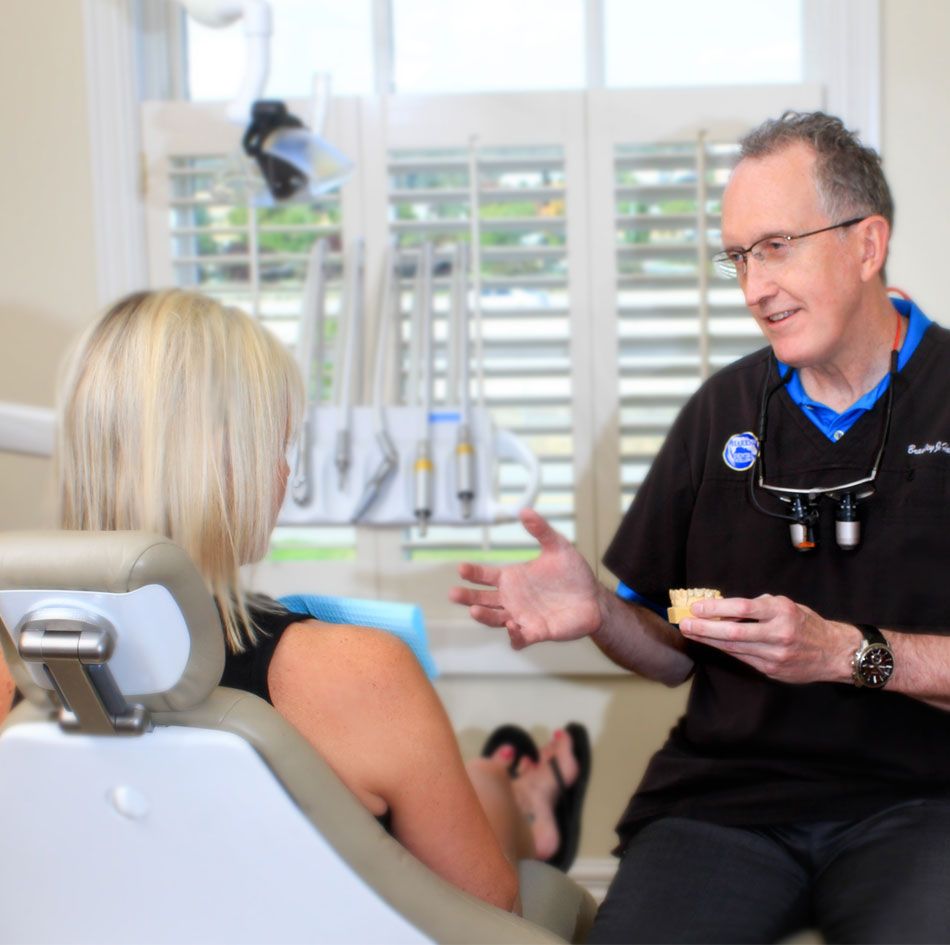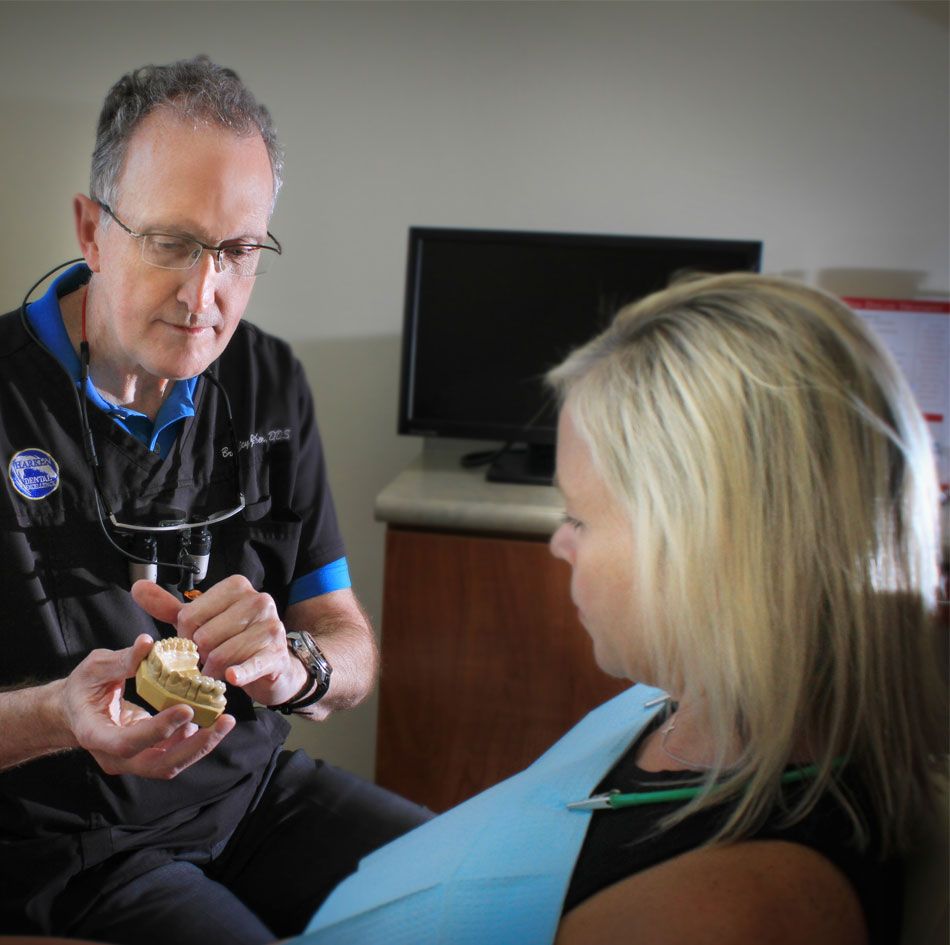Spokane Valley's #1 Cosmetic & General Dentist
The goal of dentistry, which encompasses a wide range of procedures and services, is to help you maintain your oral health, protect your natural teeth for as long as possible, and look and feel fantastic for the rest of your life.
A person’s smile can be improved using a number of advanced techniques, regardless of age. There are a variety of fascinating possibilities, including cutting-edge dental implants, incredibly lifelike porcelain veneers, and strong, professional whitening techniques.
A thorough dental examination is the first step in any smile makeover to ensure that your cosmetic issues are really that—cosmetic—and not a sign of a more serious dental condition. Once your wellbeing has been established, you can improve your smile cosmetically in a number of ways.

Cosmetic & General Dentistry Treatment in Spokane Valley
Modern dentistry offers a wide range of services to make sure your teeth stay healthy, function well and look great. These procedures include:
- Cleanings & Oral Exams, to keep your teeth and gums healthy, and catch early signs of dental disease
- Cosmetic Bonding, to repair small chips or cracks
- Crowns & Bridgework, to replace large amounts of lost tooth structure and/or missing teeth
- Dental Implants, for the longest-lasting tooth replacement available today
- Extractions, to remove unhealthy teeth that cannot be saved
- Fillings, to restore decayed teeth
- Inlays & Onlays, to fill teeth with larger cavities
- Oral Cancer Screenings, to detect a dangerous disease that can be cured if caught early
- Orthodontic Treatment, to move teeth into the right position
- Porcelain Veneers, for repairing larger chips and cracks, and reshaping teeth
- Removable Dentures, to help you smile again
- Root Canal Treatment, to rescue diseased teeth
- Sealants, to help prevent cavities
- Teeth Whitening, to brighten a faded or discolored smile
- TMD Treatment, for pain in the jaw area that can interfere with biting and chewing
- Tooth-Colored Fillings, for a completely natural, healthy look
- Tooth Decay Prevention, so you keep your natural teeth as long as possible
When to Visit the Dentist
Many people only seek emergency dental care from dentists. Unfortunately, they are not taking advantage of many preventive services that could ultimately save them a lot of suffering and money. To guarantee that oral health conditions like tooth decay and oral cancer are identified and treated as promptly as possible, regular dental appointments are necessary. Everyone should visit the dentist at least once a year, however some individuals may need to go more frequently to stay on top of problems like plaque accumulation and gum disease.
A thorough oral examination to assess the condition of your teeth and gums, an oral cancer screening to look for any early warning signs, and a professional cleaning to remove stubborn stains and restore your teeth to their original brilliant shine are all included in your regular dental visits. Take advantage of dentistry’s many benefits for you and your family.
Makeover for your Smile
The most important job you have as a member of your own smile makeover team is to communicate exactly what you don’t like about your smile and how you’d like it to be different. Before the first consultation, give some thought to the following questions:
- What do you like or dislike about the color, size, shape and spacing of your teeth?
- Are you pleased with how much your teeth show, both when you smile and when your lips are relaxed?
- Do you want teeth that are perfectly aligned and a bright “Hollywood White,” or would you prefer a more natural look with slight color, shape and shade variations?
- Would you like more or less of your gums to show when you smile?
It is extremely helpful for you to bring in pictures you have collected — of smiles you like, smiles you don’t like, and/or photos of the way your own smile used to look, if that’s the result you’re aiming for. Now is the time to get started on creating a smile that will make you feel as good as you look!
Best Cosmetic Dentist in Spokane Valley, WA - Dentist Near Me - Spokane Valley's #1 General Dentist
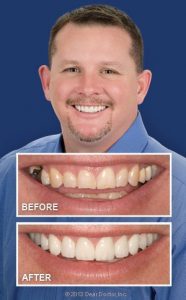 Smiling with confidence makes you feel great. A beautiful smile is also an important social and professional asset. Yet there are many people who avoid showing their teeth in public or in photographs because they don’t like what they see. If that describes you, then why not start the process of getting the smile you’ve always wanted with a smile makeover?
Smiling with confidence makes you feel great. A beautiful smile is also an important social and professional asset. Yet there are many people who avoid showing their teeth in public or in photographs because they don’t like what they see. If that describes you, then why not start the process of getting the smile you’ve always wanted with a smile makeover?
A smile makeover goes beyond simply responding to dental problems as they arise. It’s a comprehensive smile-rejuvenation plan that’s uniquely suited to your own facial features and aesthetic preferences. The results can be quite dramatic — both in terms of how your will look and how you will feel. These are the major steps involved:
Take a look. The makeover process is all about giving you the smile of your dreams. So take a good look at your smile and note what you like and don’t like about it. Some questions you can ask yourself are:
- Are your teeth as white as you’d like them to be?
- Are any teeth chipped, cracked or worn?
- Does your smile have a gummy appearance?
- Do your teeth seem too large or small?
- Do you like the alignment and spacing of your teeth
- Are you self-conscious about crookedness or gaps?
Remember, beauty is in the eye of the beholder… and that’s you! Some people want their smile to look “perfect” — and to them, that means completely straight, uniformly white teeth. Others like a slightly more natural look, and are not displeased by slight gaps or shade variations. There are lots of decisions to make, but don’t worry — dentists are skilled at helping you sort it all out!
Share your thoughts. Communication is an extremely important part of the smile makeover process. At the first makeover consultation, it helps if you describe what you would like to change in as much detail as possible. Bring along pictures of smiles you like, or of how your own smile used to look. Your makeover dentist will have some thoughts to share with you as well because dentists are trained to look at smiles in terms of facial balance. In other words, a dentist will look not only at how the elements of a smile (teeth, lips and gums) relate to each other, but also how they blend in with the face as a whole.
Make a plan. An important part of planning a smile makeover is a comprehensive dental exam. Cosmetic dentistry offers an amazing array of lifelike tooth restorations and treatments; but first, any conditions in your mouth that may jeopardize a good result must be taken care of. If your teeth are discolored, for example, the reason must be determined. You may have an underlying dental disease that needs to be treated before whitening your teeth; otherwise, the whitening may not last. Likewise, if you often drink red wine or other beverages that stain, you might do better with porcelain veneers than bleaching treatments.
Try it out. A smile makeover is an investment that is meant to last. That’s why many of the procedures performed are irreversible. So if you are contemplating some changes, it’s a great idea to try them out before you fully commit to them. There are many ways to preview the results: computer imaging, 3-D models, and even placing temporary restorations on your teeth so you can see what the final results will look and feel like in your own mouth. This also allows a fine-tuning of the makeover plan.
A “trial smile” is a great way to eliminate unknowns in the makeover process. But when it’s all done, there’s still one thing you may not be prepared for: how great it feels to flash your new smile to the world!
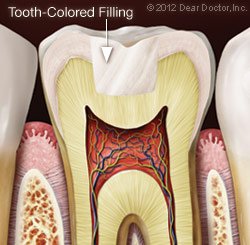 If you have never had a cavity, congratulations! If you have had one, you are not alone. About 78% of us have had at least one cavity by the time we reach age 17, according to a 2000 report by the U.S. Surgeon General. Fortunately there’s a time-tested treatment for cavities: the dental filling.
If you have never had a cavity, congratulations! If you have had one, you are not alone. About 78% of us have had at least one cavity by the time we reach age 17, according to a 2000 report by the U.S. Surgeon General. Fortunately there’s a time-tested treatment for cavities: the dental filling.
Fillings do just what the name implies — seal a small hole in your tooth, i.e., a cavity, caused by decay. This prevents the decay (a bacteria-induced infection) from spreading further into your tooth and, if untreated, continue on to the sensitive inner pulp (nerve) tissue located in the root canal. Should that happen, you would need root canal treatment.
There are a variety of materials used to fill teeth these days, but the process of filling a tooth is similar regardless. The first step is a clinical exam of the tooth with x-rays, to determine the extent of the decay. Then the decayed area of the tooth is removed, usually with a handheld instrument such as a dental drill. Of course, your tooth will be anesthetized first, so you won’t feel any discomfort. If you normally feel nervous about receiving numbing injections, it’s possible that taking an anti-anxiety medication or using nitrous oxide can help you feel more relaxed. After removing the decay, the remaining tooth structure is roughened or “etched” with a mildly acidic solution; then translucent cement is applied to bond the tooth and the filling material together.
Types of Fillings
There are two broad categories of dental fillings: metal fillings and tooth-colored fillings. Each may offer particular advantages and disadvantages in certain situations.
Metal Fillings
Amalgam — The classic “silver” filling in use for more than a century, dental amalgam is actually an alloy made up of mercury, silver, tin, and copper. The mercury combines with the other metals in the amalgam to make it stable and safe. These fillings are strong and inexpensive, but also quite noticeable. They also require relatively more tooth preparation (drilling) than other types.
Cast Gold — Among the most expensive restorative dental materials, cast gold combines gold with other metals for a very strong, long-lasting filling. It is also highly noticeable, which can be considered a plus or minus.
Tooth-Colored Fillings
Composite — A popular choice for those who don’t want their fillings to show, composite is a mixture of plastic and glass, which actually bonds to the rest of the tooth. Composites are more expensive than amalgam fillings, and the newer materials can hold up almost as long. Less drilling of the tooth is
necessary when placing composite as compared to amalgam.
Porcelain — These high-tech dental ceramics are strong, lifelike, and don’t stain as composites can. They are sometimes more expensive than composites because they may require the use of a dental laboratory or specialized computer-generated technology. While considered the most aesthetic filling, they can also, because of their relatively high glass content, be brittle.
Glass Ionomer — Made of acrylic and glass powders, these inexpensive, translucent fillings have the advantages of blending in pretty well with natural tooth color and releasing small amounts of fluoride to help prevent decay. They generally don’t last as long as other restorative materials.
What to Expect After Getting a Filling
The numbness caused by your local anesthesia should wear off within a couple of hours. Until then, it’s best to avoid drinking hot or cold liquids, and eating on the side of your mouth with the new filling. Some sensitivity to hot and cold is normal in the first couple of weeks after getting a tooth filled. If it persists beyond that, or you have any actual pain when biting, it could signal that an adjustment to your filling needs to be made. Continue to brush and floss as normal every day, and visit the dental office at least twice per year for your regular checkups and cleanings. And remember, tooth decay is a very preventable disease; with good oral hygiene and professional care, you can make your most recent cavity your last!
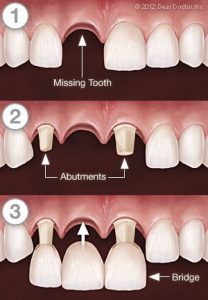 Dentistry is an art as well as a science; dental crowns offer a perfect example of this. A dental crown or “cap” is a covering that fits over a damaged, decayed or unattractive tooth. It can even replace a tooth entirely as part of dental bridgework.
Dentistry is an art as well as a science; dental crowns offer a perfect example of this. A dental crown or “cap” is a covering that fits over a damaged, decayed or unattractive tooth. It can even replace a tooth entirely as part of dental bridgework.
A crown completely covers a tooth above the gum line. This is in contrast to a dental veneer, which only covers a tooth’s front surface and needs natural tooth structure to support it. Therefore, if a tooth is missing a significant amount of structure above the gum line, a crown would be the restoration of choice.
Crowns strengthen damaged teeth, allowing them to function normally again. When crafted from today’s high-tech porcelains (dental ceramics), crowns are virtually indistinguishable from natural teeth. They can even be designed to improve upon a tooth’s original appearance.
There are other materials besides porcelain that we can use to make dental crowns, depending on what qualities are most important. For durability, cast gold can’t be beat. However, this is not always the most aesthetic choice — especially towards the front of the mouth. Other possibilities include porcelain-fused-to-metal crowns (PFM), which have a metal interior for strength and a porcelain exterior for a more natural appearance, and all-porcelain crowns with zirconia, representing the strongest ceramic. We would be happy to discuss the pros and cons of these various options with you.
Crowning or Capping a Tooth
Crowning or capping a tooth will usually take two to three visits. At the first visit, your tooth is prepared to receive its new crown. First, it is shaped to fit inside the new covering. This will involve some drilling to give the tooth a uniform shape. The tooth and the surrounding area will be numbed beforehand. If there is very little tooth structure left to begin with, the tooth may have to be built up with filling material, rather than filed down, to support the crown.
After the tooth is prepared, impressions of your teeth are taken, either digitally or with reliable, putty-like impression materials, and sent to the dental laboratory. There, the impressions will be used to make models of your teeth for the creation of a crown. The models will serve as guides to the highly skilled lab technicians, who will ensure that your new crown is designed to enhance your smile and function well within your bite.
Before you leave the office, a temporary crown will be attached to your tooth to protect it until the permanent crown is ready. At the second visit, your permanent crown will be attached to your tooth with either a resin that hardens when exposed to a special light source, or a type of permanent cement.
Creating a Bridge
Crowns can also be used to create a lifelike replacement for a missing tooth. This is done with bridgework, which spans the space of the missing tooth and requires at least three crowns. Two of those crowns will be placed over healthy teeth on either side of the missing tooth; these healthy teeth are referred to as abutment teeth. The two crowned abutment teeth become supports for a third crown placed in between them; that third crown is referred to as a pontic. If more than one tooth is missing, more crowns will be needed to bridge the gap in between the abutment teeth.
The number of abutment teeth necessary to replace missing teeth is influenced by the number of missing teeth, the size and length of the abutment tooth roots, the amount of bone support each abutment tooth has, as well as where in the mouth the missing tooth is located. For example, if you have three missing teeth, four abutment teeth may be necessary, thereby creating a seven-tooth bridge. Engineering and designing of the bridge requires an understanding of how to replace teeth, as well as the biology of the supporting gum and bone tissue.
Caring for Your Crowns & Bridgework
Crowns and bridgework require the same conscientious care as your natural teeth. Be sure to brush and floss between all of your teeth — restored and natural — every day to reduce the buildup of dental plaque. When you have crowns, it is even more important to maintain your regular schedule of cleanings at the dental office. Avoid using your teeth as tools (to open packages, for example). If you have a grinding habit, wearing a nightguard would be a good idea to protect your teeth and your investment.
 There are times when a tooth suffers damage (from decay, for example) that is too extensive to be treated with a simple filling — but not extensive enough to need a full-coverage crown. In these cases, the best option for restoring the tooth may be an inlay or onlay.
There are times when a tooth suffers damage (from decay, for example) that is too extensive to be treated with a simple filling — but not extensive enough to need a full-coverage crown. In these cases, the best option for restoring the tooth may be an inlay or onlay.
Both inlays and onlays are considered “indirect” fillings, meaning that they are fabricated outside the mouth (generally at a dental laboratory), and then bonded to the tooth by the dentist. This is in contrast to a “direct” filling, which is applied directly to the cavity by the dentist in one office visit.
An indirect filling is considered an “inlay” when it fits within the little points or “cusps” of a back (premolar or molar) tooth. It is an “onlay” if it covers one or more of these cusps. Either way, the procedure for placing an inlay or onlay is the same.
How Inlays & Onlays Work
Getting an inlay or onlay is very much like what you would experience having a crown placed, with one important distinction: less of your natural tooth structure will need to be removed by drilling when you receive an inlay or onlay. When you get a crown, the tooth needs to undergo significant reshaping so that it will fit inside its new covering. Since dentistry’s goal is to preserve as much of your natural tooth structure as possible, inlays and onlays may be recommended instead of crowns when a tooth can be restored with this more conservative type of treatment.
The first steps in getting an inlay or onlay are numbing the tooth and surrounding area with a local anesthetic, and then removing the decay. This is done in order to prevent the decay, which is actually a type of infection, from progressing deeper into the tooth.
Once the tooth has been prepared, an impression of it is made (either digitally or with a putty-like material) and sent to the dental laboratory. There, the impression is used to make a model of your tooth for the creation of your inlay/onlay. The final restoration can be made out of gold or a tooth-colored ceramic or resin.
Before you leave the office, a temporary filling will be attached to your tooth to protect it until the permanent restoration is ready. At your second visit, the permanent inlay/onlay will be attached to your tooth with either a resin that hardens when exposed to a special light source, or a type of permanent cement.
Inlays and onlays are strong, long-lasting, and require no greater level of care than any other tooth. Conscientious daily brushing and flossing, and regular professional cleanings at the dental office are all you need to make sure your restoration lasts for years to come.
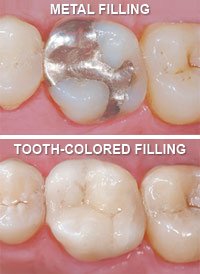 If you could have fillings that matched the natural color of your teeth so well that nobody could tell the difference, would you choose them over metal?
If you could have fillings that matched the natural color of your teeth so well that nobody could tell the difference, would you choose them over metal?
We thought so! Both scientific studies and clinical experience have shown that tooth-colored restorations (fillings) are safe, reliable and long-lasting. Plus, they look great.
Not only do tooth-colored fillings offer an aesthetic alternative to “silver” (dental amalgam) fillings that’s hard to match — they may also allow for a more conservative treatment method that preserves more of the tooth’s structure. When you put these advantages together, it’s no wonder some dentists say we’re moving toward a “post-amalgam” era.
Tooth-colored fillings are made of a blend, or “composite,” of plastic resins and silica fillers. These substances mimic many of the qualities of natural tooth structure, such as wear-resistance and translucency. Dental composites also help strengthen teeth.
Based on looks alone, it’s easy to see why you’d want a tooth-colored restoration in the front of your mouth. But to understand some of the other advantages composite resins offer — even for back teeth — let’s look a little closer at the tooth restoration process.
The Process of Filling a Tooth
There are many reasons why a tooth may need to be filled or restored: decay and chipping are two common ones. No matter which material is chosen, the procedure is almost the same. After the area has been anesthetized (usually by a numbing injection), the tooth is “prepared” by removing decay and making it ready for the restoration. Next, the filling material is placed directly into the tooth. Once it has securely bonded to the tooth structure, the process is essentially complete.
Now, here’s the difference: In order to achieve a good structural bond with a traditional amalgam filling, it is often necessary to shape the tooth by making a series of “undercuts” that help hold the material in place. This means that some healthy tooth material must be removed, leaving less of the tooth’s structure intact. In time, the structurally-weakened tooth can be prone to cracking.
But composite resin fillings don’t require undercutting to make a strong union — instead, they form an intimate physical and mechanical bond directly to the prepared tooth. This more conservative treatment may ultimately lead to a better and longer-lasting restoration.
When Can Tooth-Colored Fillings Be Used?
Composite resins are generally appropriate for small to moderate-sized restorations — which encompass the most common types of fillings. They are durable, fracture-resistant, and able to withstand chewing pressure. Depending on how much of the tooth needs restoration, the procedure may be accomplished in just one visit. Alternatively, if a large volume of tooth material must be replaced, a part may be fabricated outside the mouth and later bonded to the tooth.
Whatever the situation, the best way to determine whether tooth-colored fillings are right for you is to come in and consult with us. We can explain the appropriate options and help you select the best way to proceed with treatment. Either way, you’ll be able to achieve — and keep — a healthy-looking smile.
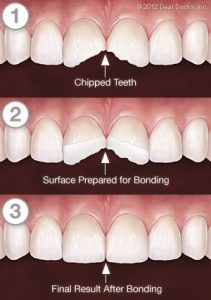 We are proud of the ways in which dentistry can restore broken or decayed teeth to full beauty and function. One of the easiest and least expensive ways of doing this is with dental bonding.
We are proud of the ways in which dentistry can restore broken or decayed teeth to full beauty and function. One of the easiest and least expensive ways of doing this is with dental bonding.
Bonding uses tooth-colored materials to replace missing tooth structure or hide cosmetically unappealing minor defects in a tooth — chips, discoloration, and even minor spacing irregularities. Bonding materials are called “composite resins” because they contain a mixture of plastic and glass, which adds strength and translucency. The composite actually bonds, or becomes one, with the rest of the tooth.
Composite resins come in a variety of tooth shades for truly lifelike results. When bonding is done with a skilled hand and an artistic eye, it may be impossible to distinguish the bonded tooth from its neighbors. Though bonding will not last as long as a dental veneer, it also does not require the involvement of a dental laboratory and, most often, can be done without drilling of the tooth. It’s a particularly good solution for teens, who often need to wait until their teeth have finished maturing before choosing a more permanent type of dental restoration.
The Dental Bonding Process
Because it does not involve dental laboratory work, tooth bonding can usually be accomplished in a single visit to the dental office. Expect the whole procedure to take 30 minutes to an hour. First, the surface of the tooth to be bonded will be cleaned so it is plaque-free. The surface will then need to be “etched” with an acidic gel that opens up tiny pores in the surface. After the etching gel is rinsed off, the liquid composite resin in a well-matched shade is painted on in a thin layer, filling these tiny pores to create a strong micromechanical bond. A special curing light is used to harden this bonding material. Once the first layer is cured, another layer is painted on and cured. Layers can continue to be built up until the restoration has the necessary thickness. The bonding material is then shaped using a dental drill to give it just the right form. Once the tooth not only looks great but fits in perfectly with your bite, it will receive a final polishing.
Caring for Bonded Teeth
Bonded teeth should be brushed and flossed daily, and professionally cleaned at the dental office twice per year, just the same as the rest of your teeth. The most important thing to keep in mind about caring for your bonded tooth is that composite resin can absorb stain, just as natural teeth can. Therefore, you will want to avoid smoking, red wine, coffee and tea to the extent possible. Also, while composite can darken, it cannot be lightened. So if you are thinking about having your teeth whitened, it should be done before your tooth is bonded so that a composite shade can be selected to match the lighter color of your whitened teeth. If you whiten your teeth after bonding, the bonded tooth may not match all the rest. Finally, try not to bite your nails, hold writing implements in your mouth, or use your teeth in other ways that could put excessive force on the bonding material and chip it. With proper care, a bonded tooth should stay beautiful for 3 to 10 years.
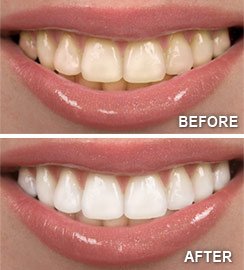 It’s hard to imagine anything more appealing than a sparkling, white smile. Yet our teeth rarely stay as white as we’d like them to without a little help. Fortunately, that help is available at the dental office.
It’s hard to imagine anything more appealing than a sparkling, white smile. Yet our teeth rarely stay as white as we’d like them to without a little help. Fortunately, that help is available at the dental office.
Teeth whitening done in a professional dental setting is a safe, effective way to brighten your smile. It’s also perhaps the most economical cosmetic dental procedure. Depending on the whitening method you choose, results can be dramatic: in-office whitening, for example, can lighten teeth three to eight shades in a single hour.
Professionally supervised whitening will work faster, and protect sensitive gums and tooth-root surfaces better, than over-the-counter whitening products. Having an oral exam before you begin any whitening process is an important first step to make sure your tooth discoloration is not the result of a dental condition in need of treatment. Also, please be aware that it can be risky to have whitening solutions applied to your teeth by untrained personnel in shopping malls. If you have any questions about which whitening method would be best for you, talk to us first.
Professional Whitening Methods
Professional whitening makes use of high-concentration bleaching gels that are not available over the counter.
- In-Office Whitening — This technique offers the fastest results with the most powerful whitening solutions available. First, your gums and tooth-root surfaces will be covered with a protective barrier to ensure your safety. A thin plastic device known as a retractor will hold your lips and cheeks away from your teeth as a professional-strength hydrogen peroxide gel is applied. The gel will be left on for about an hour. When it is removed, the results will be obvious immediately.
- Take-Home Whitening — This is another effective way to whiten your teeth, though you will play a greater role in ensuring the best possible results and several weeks may be needed to achieve your desired level of whiteness. First, a mold of your teeth will be taken and then two thin, flexible plastic mouth trays will be custom-made for you — one for the top teeth and one for the bottom. You will fill the trays with whitening gel and then position the trays over your teeth. The trays are left in usually for about an hour at a time.
Caring for Your Whitened Smile
There are lots of things you can do to make sure your whitening results last as long as possible, and this will vary from person to person (six months to two years or even longer). First of all, please maintain your usual, conscientious routine of brushing and flossing every day, and keep up with your regular schedule of professional cleanings at the dental office. Avoid foods and beverages that stain, including red wine, tea and coffee. If you smoke, use your newly whitened teeth as an impetus to quit — a good idea in any event! A minor touch-up every so often, either at home or at the dental office, can keep your smile bright and beautiful for years.
 Full or partial tooth loss, if left untreated, doesn’t just affect a person’s self-image — it can also increase the risk of developing nutritional problems and other systemic health disorders. Fortunately, there’s a reliable and time-tested method for treating this condition: full or partial dentures.
Full or partial tooth loss, if left untreated, doesn’t just affect a person’s self-image — it can also increase the risk of developing nutritional problems and other systemic health disorders. Fortunately, there’s a reliable and time-tested method for treating this condition: full or partial dentures.
Dentures are just one option for replacing missing teeth; some of the others include fixed bridgework and dental implants. Each method has its particular pluses and minuses, which should be carefully considered. There are also several varieties of dentures available to address specific issues, from partial dentures to implant-supported overdentures. The best option for you will depend on your individual situation.
How Do Removable Dentures Work?
Full or partial dentures consist of a gum-colored base made of plastic resin, which fits over the remaining alveolar (bone) ridge that formerly held the teeth. The prosthetic teeth projecting from the base are designed to look and function just like your natural teeth. Dentures are held in place primarily by the suctioning effect of their close fit against the alveolar ridges — that’s why it’s so important that they are fitted properly. The upper denture also gets extra support from the large surface area of the roof of the mouth (palate), which generally makes it extremely stable.
At first, wearing dentures may require some getting used to in terms of talking and eating, as the dentures become “balanced” in the space formerly occupied by the teeth. But over time, the muscles, nerves and ligaments of the mouth learn to work in new ways, which allows these functions to occur normally. Dentures also help support the facial skeleton and the soft tissues of the lips and cheeks, which can help create a more youthful appearance.
Types of Dentures in Spokane Valley
Immediate Dentures: These are usually a temporary means of helping you transition to successful denture wearing. Because of the muscular readjustment required, as well as the natural shrinkage of gums, the dentures which are placed immediately after tooth extraction won’t fit as well as permanent dentures made when the healing is complete. They do, however, provide you with new teeth right away, and give you time to adjust.
Conventional Full Dentures: After a period of time, permanent dentures that conform to your mouth with near-perfect accuracy can be fabricated. These are carefully crafted to look as much like your own natural teeth as possible, and are able to function properly in your mouth for a long time.
Implant-Supported Overdentures: To increase the stability of a lower or upper denture, it’s possible for it to be securely anchored using two or more dental implants. The upper jaw requires more implants (generally three or more) than the lower jaw due to a lesser bone density. Many people find this option offers a great balance of comfort, functionality and value.
Types of Partial Dentures
Transitional Partial Dentures: These relatively inexpensive removable plastic dentures serve as a temporary tooth replacement and space maintainer as you wait for your mouth to heal from tooth extraction, for example. Once the healing process is complete, dental implants can be placed.
Removable Partial Dentures (RPDs): Usually made of cast vitallium, these well-constructed, metal-based removable partial dentures are much lighter and less obtrusive than those made of plastic. They are a little more expensive than plastic dentures but will fit better. They are, however, much less expensive than implants or fixed bridgework.
How Dentures Are Made and Fitted
Making quality dentures is a blend of science and art. First, an accurate impression (mold) is made of the alveolar ridges on the top and bottom of your mouth. The base of the denture is made from this mold in a dental laboratory. Working together, the dentist and lab technician choose from among many different sizes and shapes of prosthetic teeth to re-create a natural-looking smile. When everyone is satisfied with the result, the temporary dentures are made in permanent form.
To enable normal speech and eating, it’s crucial to balance your bite. This means that the upper and lower dentures come together and properly stabilize each other. The form and function of the dentures are carefully checked to ensure that they are working and fitting properly.
What to Expect After You Get Dentures
If you’ve recently lost your teeth and received an immediate denture, it’s normal to find some tissue shrinkage and bone loss occurring. Therefore, in several months you may find that your immediate dentures no longer fit well. You will have two choices at this point: You can have your immediate (temporary) dentures re-lined. This means that material is added under the denture’s base to better conform to the new contours of your alveolar ridge. A better option is to move to a set of conventional full dentures, which will last longer and fit better. With proper care, dentures offer a functional, aesthetic and economical solution to the problem of tooth loss.
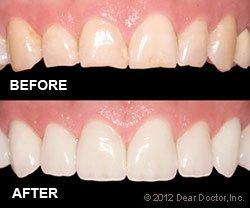 What makes a smile beautiful? That’s a complex question, but some qualities of a lovely smile are immediately identifiable: good tooth color, shape and alignment are a few of the most important ones. If your teeth could use improvement in any of these categories, porcelain veneers could be just what you’re looking for.
What makes a smile beautiful? That’s a complex question, but some qualities of a lovely smile are immediately identifiable: good tooth color, shape and alignment are a few of the most important ones. If your teeth could use improvement in any of these categories, porcelain veneers could be just what you’re looking for.
You may already know that a veneer is a thin covering over another surface. In dentistry, a veneer is a wafer-thin layer of super-strong porcelain that convincingly substitutes for natural tooth enamel. When bonded to your teeth, veneers can create a natural-looking, beautiful new surface. That’s because dental porcelain, like natural tooth enamel, is translucent and tough. But it doesn’t stain like tooth enamel does.
Recent years have brought remarkable advances in dental porcelain technology. These days, veneers can be made so thin that they can sometimes be bonded directly onto your existing tooth surface. In other cases, a very thin layer of tooth enamel — as thin as the veneer itself — needs to be removed to fit the new porcelain surface and make it look as lifelike as possible. Either way, the results are sure to make you smile.
Versatility of Porcelain Veneers
Veneers can be used to improve any of the following characteristics of your teeth:
- Color — Teeth can become stained by the foods and drinks we like, from smoking, and even normal aging. Veneers are available in numerous shades, from the most natural to the brightest Hollywood white.
- Size & Shape — Teeth can become worn down from grinding habits, or may not have the shape or size you want to begin with. For example, some people consider rounder teeth more feminine and squarer teeth more masculine. Veneers can be shaped and sized in whichever way is most flattering to your face.
- Alignment & Spacing — Veneers can be used to close small gaps between teeth or make slight corrections in alignment while improving tooth color and shape.
Limitations of Porcelain Veneers
There are some situations in which veneers would be inappropriate. For example, if you have significantly misaligned teeth or a large gap, orthodontics might be a more appropriate solution than veneers. And if you have lost a lot of tooth structure from decay or trauma (or a particularly severe grinding habit), it might be better to restore your teeth with porcelain crowns that cover the entire tooth.
Creating a New Smile with Porcelain Veneers
The first step in creating a new smile with porcelain veneers is to communicate exactly what you don’t like about your smile as it is now. It’s a great idea to bring in pictures of smiles you do like, as a starting point for discussion. It’s possible to see how veneers would look on your teeth in one of several ways. A model of your teeth can be created over which wax “veneers” can be placed; sometimes acrylic (plastic) or tooth-colored filling material can be placed directly onto your teeth to demonstrate the effect veneers would have on them.
Once the plan has been agreed upon, your teeth will be prepared by removing a small amount of enamel, if this step is necessary. Molds of your teeth will be taken and used by a skilled dental laboratory to create your veneers, and you will receive a temporary set of veneers to wear during the few weeks it will take to create your permanent veneers. When the veneers come back from the lab, they will be cemented onto your teeth.
Caring for Your Veneers in Spokane Valley
Just like the teeth nature gave you, teeth restored with veneers need gentle brushing and flossing every day. This will remove dental plaque and ensure good gum tissue health around the veneers. Regular checkups at the dental office will remain as important as always to your oral and general health. And keep in mind that as tough as veneers are, they may not be able to withstand forces that come from using your teeth as tools (to open packages, for example) or biting into very hard foods like candy apples — which isn’t good for your natural teeth, either! And if you grind or clench your teeth at night, you might be advised to get a custom-made nightguard to protect your veneers — and your investment.
 Sometimes little defects in teeth can attract more than their fair share of attention. The eye often seems drawn to the tiny chip in a front tooth; the slight mismatch in tooth size among adjacent teeth; the extra-pointy canine. If you find yourself staring at these subtle yet distracting features in your own smile, help is available — often with a minimally invasive, relatively inexpensive procedure known as tooth contouring (reshaping).
Sometimes little defects in teeth can attract more than their fair share of attention. The eye often seems drawn to the tiny chip in a front tooth; the slight mismatch in tooth size among adjacent teeth; the extra-pointy canine. If you find yourself staring at these subtle yet distracting features in your own smile, help is available — often with a minimally invasive, relatively inexpensive procedure known as tooth contouring (reshaping).
Tooth contouring involves removing a tiny amount of tooth enamel with a drill to sculpt a more pleasing shape and make the tooth fit in better with its neighbors. The tooth is then polished for a smooth finish. The procedure is most often used on the upper front incisors and canines, which are your most visible teeth.
Cosmetic problems that can be corrected with tooth contouring include: small chips, uneven tooth length, slight overlaps, and tooth edges that are too flattened or pointy. It can even be used to correct minor bite problems from teeth touching unevenly during contact. Conversely, your teeth should not be reshaped if any bite imbalances could result from it. In that case, one of several other highly effective cosmetic dental procedures would be recommended. Tooth contouring can also be used to give teeth a more feminine or masculine shape, simply by rounding or squaring the edges.
What to Expect With Tooth Contouring
The first step in the contouring procedure is to examine your teeth and diagnose how the reshaping will accomplish your goal of smile enhancement or correct a bite problem if you have one. This will ensure that the teeth being reshaped will not only look better but also will be healthy. Sometimes a reshaping of the root surfaces is required to protect you from gum disease. In that case, an x-ray may be necessary to isolate and protect the sensitive inner tissue (the pulp). However, most often tooth contouring only involves the removal of a bit of enamel — the hard outer covering of the tooth. Because enamel is not living and contains no nerves, you will likely not need even a local anesthetic.
You will probably feel some vibration as your tooth is gently sculpted, and then polished smooth. Reshaping one tooth usually takes less than half an hour — and the results will be obvious as soon as you look in the mirror! Sometimes reshaped teeth can be a little sensitive to hot or cold after the procedure, but this should last no more than a day or two.
Tooth contouring can be combined with whitening for a dramatically younger-looking smile. It’s also often used in conjunction with cosmetic bonding or dental veneers — both of which can be used to reshape teeth with larger imperfections.
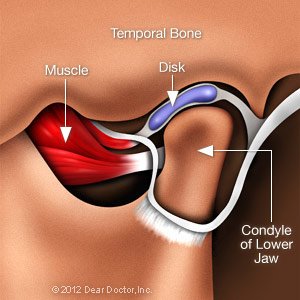 If you experience ongoing pain in the area near your ear, your jaw or the muscles on the side of your face, possibly accompanied by a clicking or popping sound or restricted jaw movement, you may be suffering from TMD — an abbreviation for Temporomandibular disorders. Sometimes people incorrectly use the term TMJ to refer to these problems, when in fact TMJ is the abbreviation for the temporomandibular joint — or jaw joint — itself. So while you definitely have a TMJ (two of them in fact), you may or may not have TMD.
If you experience ongoing pain in the area near your ear, your jaw or the muscles on the side of your face, possibly accompanied by a clicking or popping sound or restricted jaw movement, you may be suffering from TMD — an abbreviation for Temporomandibular disorders. Sometimes people incorrectly use the term TMJ to refer to these problems, when in fact TMJ is the abbreviation for the temporomandibular joint — or jaw joint — itself. So while you definitely have a TMJ (two of them in fact), you may or may not have TMD.
TMD, then, describes a group of conditions characterized by pain and dysfunction of the TMJ and/or the muscles surrounding it. It’s not always so easy to figure out exactly what’s causing these symptoms, but the good news is that most TMD cases resolve themselves with the help of conservative remedies that you can try at home. In fact, it’s important to exhaust all such reversible remedies before moving on to anything irreversible, such as bridgework or surgery.
The two TMJs that connect your lower jaw, the mandible, to the temporal bone of the skull on either side, are actually very complex joints that allow movement in three dimensions. The lower jaw and temporal bone fit together as a ball and socket, with a cushioning disk in between. Large pairs of muscles in the cheeks and temples move the lower jaw. Any of these parts — the disk, the muscles or the joint itself — can become the source of a TMD problem. If you are in pain, or are having difficulty opening or closing your jaw, a thorough examination can help pinpoint the problem area; then an appropriate remedy can be recommended.
Causes of TMD & TMJ
As with any other joint, the TMJ can be subject to orthopedic problems including inflammation, sore muscles, strained tendons and ligaments, and disk problems. TMD is also influenced by genes, gender (women appear to be more prone to it), and age. Physical and psychological stress can also be a factor. In some cases, jaw pain may be related to a more widespread, pain-inducing medical condition such as fibromyalgia (“fibro” – connective tissues; “myo” – muscle; “algia” – pain).
Signs and Symptoms of TMD
Clicking Sounds — Some people with TMD hear a clicking, popping or grating sound coming from the TMJ when opening or closing the mouth. This is usually caused by a shifting of the disk inside the joint. Someone standing next to you might even be able to hear it. Clicking by itself is actually not a significant symptom because one third of all people have jaw joints that click, studies show. However, if the clicking is accompanied by pain or limited jaw function — the jaw getting “stuck” in an open or closed position, for example — this would indicate TMD.
Muscle Pain — This can be felt in the cheeks (masseter muscles) and temples (temporalis muscles), where the two big pairs of jaw-closing muscles are located. If you feel soreness and stiffness upon waking up in the morning, it’s often related to habits such as clenching and/or grinding the teeth at night. If you have this type of nocturnal habit, a custom-made nightguard should be very helpful in decreasing the force applied to your teeth, which will in turn allow your muscles to relax and relieve pressure on your jaw joints. Other self-care remedies are discussed below (please see Relieving the Pain).
Joint Pain — Pain that’s actually coming from one or both jaw joints technically would be described as arthritis (“arth” – joint; “itis” – inflammation) of the TMJ. Radiographs (x-ray pictures) show that some people have arthritic-looking TMJs but no symptoms of pain or dysfunction; others have significant symptoms of pain and dysfunction but their joints look normal on radiographs. There is no cure for arthritis anywhere in the body, but medication can sometimes help relieve arthritic symptoms.
Relieving TMJ Pain
Once you have been examined, a strategy for treating your condition and managing your pain can be developed. Sometimes a temporary change to a softer diet can reduce stress on the muscles and joints. Ice and/or moist heat can help relieve soreness and inflammation. Muscles in spasm can also be helped with gentle stretching exercises. Non-steroidal anti-inflammatory medications and muscle relaxants can also provide relief.
Other Treatment Options
Severe TMD cases may require more complex forms of treatment, which might include orthodontics, dental restorations like bridgework, or minor procedures inside the joint such as cortisone injections or lavage (flushing) of the joint. It’s rare for major surgery ever to be necessary in a case of TMD. Again, it’s important to try the wide range of conservative, reversible treatments available, and give them enough time to work as they almost always prove effective. The first step is an examination at the dental office.
 You know it instinctively: A good night’s sleep is essential for good health. It makes you feel rested and ready to take on the world. Yet many people don’t get the sleep they need. Sometimes this is related to sleep-related breathing disorders (SRBD) — their own, or those experienced by their sleeping partners.
You know it instinctively: A good night’s sleep is essential for good health. It makes you feel rested and ready to take on the world. Yet many people don’t get the sleep they need. Sometimes this is related to sleep-related breathing disorders (SRBD) — their own, or those experienced by their sleeping partners.
SRBD is characterized by recurrent episodes of reduced or interrupted respiratory airflow. This is caused by soft tissues near the back of the throat collapsing during sleep so that they partially close off the windpipe. These tissues — the tongue, for example — can vibrate as air passes by, causing snoring. Snoring is often worsened sleeping on one’s back because this encourages the lower jaw to slip back, which in turn pushes the tongue in front of the airway.
Snoring & Sleep Apnea Treatments in Spokane Valley
Loud snoring often disturbs the person in the bed who isn’t the one doing it, robbing him or her of vital sleep. The snorer, on the other hand, may seem to be slumbering peacefully, but this might not actually be the case. Chronic loud snoring is a common symptom of Obstructive Sleep Apnea (OSA; “a” – without; “pnea” – breath), which occurs when the upper airway is blocked to the point of causing significant airflow disruption, or even no airflow whatsoever for 10 seconds or more. This can be dangerous as reduced airflow into the lungs lowers blood-oxygen levels.
A person with sleep apnea may wake 50 or more times per hour — that’s almost once a minute! — without having any memory of it. These awakenings, called micro-arousals, last just long enough to restore muscle tone to the airway so the individual can breathe. Unfortunately, all those micro-arousals preclude deep and restful sleep.
What to Look Out For
Obstructive Sleep Apnea is a serious matter as it can lead to heart problems and other health issues. It’s possible you may have OSA if you snore and also suffer from any of the following:
- Excessive daytime sleepiness
- Irritability
- Poor memory/confusion
- Accident proneness
- Night sweats
- Morning headaches
- High blood pressure
- Obesity
How Dentistry Can Help
By now you’re probably wondering: What does my dentist have to do with all this? Here’s the connection: Snoring or sleep apnea can sometimes be treated with an oral appliance available at the dental office that’s designed to hold the lower jaw forward during sleep. This repositioning of the jaw moves the tongue away from the back of the throat, reducing the potential for obstruction. This treatment is backed by a great deal of scientific evidence; it’s a good remedy to try before moving on to more complicated breathing devices or surgery to remove excess tissues in the throat.
Only a dentist can fabricate, fit, adjust, monitor, and treat complications associated with Oral Appliance Therapy used in managing SRBD. So if you or a loved one is experiencing any combination of the signs and symptoms mentioned above, a consultation with a dental professional is a good idea.
 With proper care, your teeth can last a lifetime. But some amount of wear as we age is normal. By “wear,” we mean loss of tooth structure. Wear starts with loss of the hard, translucent enamel that forms the outer covering of teeth, and might, in more serious cases, progress to the softer inner tooth structure known as dentin.
With proper care, your teeth can last a lifetime. But some amount of wear as we age is normal. By “wear,” we mean loss of tooth structure. Wear starts with loss of the hard, translucent enamel that forms the outer covering of teeth, and might, in more serious cases, progress to the softer inner tooth structure known as dentin.
Enamel is actually the human body’s hardest substance. It is highly mineralized and non-living, in contrast to bone and dentin which are living tissues. Enamel is highly resistant to wear and chemical attack, as it would have to be given what your teeth do every day: bite, chew, and come in contact with acidic foods and drinks.
Still, it is possible for tooth enamel to wear down for various reasons. Your body has ways of compensating for minor wear. But when tooth wear becomes more significant, intervention may be necessary to keep your bite functioning properly and protect your teeth.
Types of Tooth Wear
Tooth wear can result from one or more of these processes:
Abrasion: This is caused by the interaction of teeth and other materials rubbing or scraping against them. The most common source of abrasion is traumatic toothbrushing, meaning that you are using a toothbrush that’s too hard or applying too much force when you brush. This can affect the root surfaces of your teeth just below the gum line or the enamel above the gum line. Other causes of abrasion can include improper use of toothpicks and dental floss. Some dental appliances such as partial dentures or retainers that are frequently taken in and out of the mouth can also abrade teeth. Abrasion can also result from a diet loaded with abrasive foods like sun flower seeds and nuts or habits such as nail-biting and pen-chewing.
Attrition: This is an effect of tooth-to-tooth contact, which happens many times throughout the day as your teeth bite and chew food. Biting and chewing normally generate forces between 13 – 23 pounds. Yet people who have clenching and grinding habits (of which they might not even be aware) can subject their teeth to forces up to 10 times that. This can damage teeth.
Erosion: When your teeth come in contact with acidic substances in your diet, the acid can actually erode (dissolve) the enamel on your teeth. Culprits of this kind of tooth wear often include sodas, sports drinks and so-called energy drinks. Certain fruit juices are also acidic. Confining these drinks to mealtimes and swishing water in your mouth after drinking them can help prevent this erosion.
Abfraction: This refers specifically to the loss of tooth enamel at the necks of the teeth (the thinner part right at the gum line). While this type of wear is not clearly understood and the cause is debated in dentistry, loss of tooth structure at the neck of teeth does happen. It is believed to be caused by tooth flexion from biting forces. Abrasion and erosion can contribute to this problem.
Treating Worn Teeth in Spokane Valley
In order to treat your worn teeth, the cause of the wear must be determined during a simple oral examination at the dental office. Once the cause has been identified, the stresses on your teeth can be reduced if need be. For example, you may need instruction on gentle, effective tooth brushing techniques; or some changes to your diet. If you have a clenching or grinding habit, a mouthguard can be custom-made for you that will protect your teeth during sleep or periods of high stress.
Lost tooth structure sometimes needs to be replaced so your bite functions properly and your teeth look great once again. Depending on the situation, this can be done with bonding, veneers, or crowns. Fortunately, modern dentistry can restore the normal shape, appearance and function of worn teeth — beautifully and successfully!
 Some people fail to receive the benefits of modern dental treatment because of a simple yet seemingly overwhelming problem: Fear. It isn’t uncommon to have a little anxiety about an upcoming dental procedure. But if your fears have kept you away from the dental office when you know you really should go — take heart! Conscious sedation with nitrous oxide can help you lose that anxiety, and make the whole experience so stress-free that you may not even remember it when it’s over.
Some people fail to receive the benefits of modern dental treatment because of a simple yet seemingly overwhelming problem: Fear. It isn’t uncommon to have a little anxiety about an upcoming dental procedure. But if your fears have kept you away from the dental office when you know you really should go — take heart! Conscious sedation with nitrous oxide can help you lose that anxiety, and make the whole experience so stress-free that you may not even remember it when it’s over.
Nitrous oxide, a colorless gas with a slightly sweet odor, has been used in medicine for about a century; however its outdated nickname, “laughing gas,” is undeserved. It’s a safe and effective method of administering conscious sedation — which means that you’ll stay awake during the procedure. But when nitrous oxide is used in combination with a local anesthetic, you won’t feel pain or anxiety. In fact, many patients report a feeling of well-being during this type of sedation. All bodily functions remain normal during the administration of nitrous oxide, and its effects wear off quickly afterwards.
How Is Nitrous Oxide Administered?
As a form of conscious sedation, nitrous oxide is inhaled through a small mask that fits comfortably over your nose. The gas is mixed with oxygen as it is being delivered, and both gases are always kept at a level that is safe for the body. In just a few minutes, you may start to experience a floating sensation, and perhaps some tingling in the hands and feet. That’s a sign that the sedation is working. Once it has been verified that you’re calm and comfortable, and that the dose is correct, your dental procedure can begin.
Nitrous oxide itself isn’t a substitute for a local anesthetic — it’s considered an anxiolytic, which means it makes anxiety disappear. For some procedures, you may still need an anesthetic injection. The difference is, you won’t mind. Yet, you won’t be asleep — you’ll be able to speak, be aware of what’s going on, and you will remain in control during the procedure. In fact, the dose can be fine-tuned to just the level of sedation you need.
When the procedure is over, the flow of nitrous oxide is decreased to zero, and the oxygen may be increased. After resting in the chair for a few minutes, you’ll be able to sit up, and soon you can resume normal activities like driving. Although the experience has been compared to “having a couple of drinks,” there is very little “hangover” effect afterward.
Who Can Benefit From Nitrous Oxide?
Most people whose anxiety would otherwise keep them out of the dental chair can benefit from conscious sedation with nitrous oxide. Before beginning treatment, we will take a complete medical history, including your use of both prescription and non-prescription medications. If you are pregnant, have COPD (Chronic Obstructive Pulmonary Disease) or some other pulmonary diseases, or are taking certain drugs, it may not be right for you. However, if you feel that you would benefit from a more stress-free experience in the dental office, ask about nitrous oxide conscious sedation.
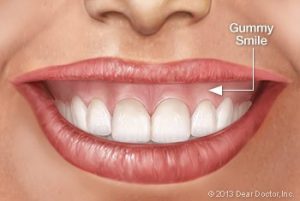 Some people feel self-conscious about smiling because they believe their gums are too prominent. Though we each have our own definition of what makes a smile beautiful — including how much gum is too much — a smile will usually be perceived as “gummy” when 4 millimeters (just over an eighth of an inch) of gum tissue shows. If your smile looks gummy to you, it’s important to figure out exactly what’s causing this. Only then can the appropriate cosmetic dental or periodontal (gum) procedures be recommended to give you a more pleasing appearance of the gums and teeth.
Some people feel self-conscious about smiling because they believe their gums are too prominent. Though we each have our own definition of what makes a smile beautiful — including how much gum is too much — a smile will usually be perceived as “gummy” when 4 millimeters (just over an eighth of an inch) of gum tissue shows. If your smile looks gummy to you, it’s important to figure out exactly what’s causing this. Only then can the appropriate cosmetic dental or periodontal (gum) procedures be recommended to give you a more pleasing appearance of the gums and teeth.
Causes of Gummy Smiles
Gummy smiles may be caused by one or more factors relating to the gums themselves, the teeth, or even the lip or jaw. Each of these areas will require a different approach to solving the problem. Let’s look at some of the ways a gummy smile can be corrected:
Gums. If your teeth appear too short in relation to your gums, it could be that they are being covered up by too much gum tissue. This problem can be solved with a periodontal plastic surgery technique called “crown lengthening,” which involves removing and reshaping the excess tissue to expose the full length of teeth.
Teeth. There are natural variations in the tooth-eruption process that can result in shorter than normal teeth and gumminess of the smile. If that’s the case, your teeth can be made to appear longer by capping (crowning) them or covering them with thin porcelain veneers. It’s also possible that your teeth have become worn down over time, especially if you have a grinding habit. When this happens, it can cause what is known as compensatory eruption. To compensate for the wear and maintain a functional bite, the teeth actually begin to move (or erupt) very slowly outward from the gum. This makes the smile appear gummier because the gums, which are attached to the teeth, move with them as they erupt. In some cases orthodontic treatment can be used to move the affected teeth back up into correct position. Afterwards, the worn-down teeth would usually be restored with porcelain crowns or veneers.
Lip. On average, the upper lip moves 6 to 8 millimeters from its normal resting position to a full smile. If the lip is hypermobile, meaning it rises much farther up, more gum tissue will be revealed. Here the action of the muscles that control the lip will need to be modified so they don’t raise it quite so high. Treatment can range from Botox shots that temporarily paralyze the muscles (for about six months), to surgery that permanently restricts how high the lip can move, referred to as a lip stabilization procedure.
Jaw. Sometimes the upper jaw (maxilla) is too long for the face, a condition referred to as Vertical Maxillary Excess. If this is the case, the jaw would need to be repositioned with orthognathic surgery (“ortho” – straighten; “gnathos” – jaw). Of all the treatment listed here, this one is the most complex — but it can achieve dramatic results.
As you can see, there is no one-size-fits-all approach to correcting a gummy smile. However, there are various techniques that can achieve dramatic improvements.
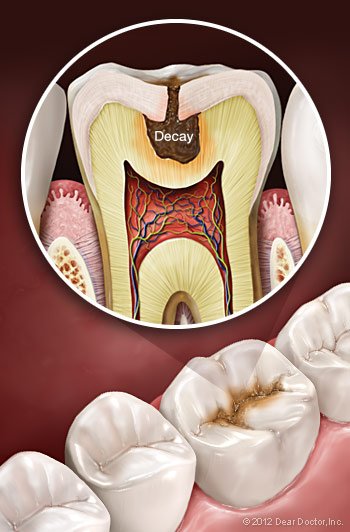 Tooth decay is often called the second most prevalent human disease, after the common cold. Without effective treatment (as was the case through most of history) it can lead to pain, tooth loss, and sometimes worse illnesses. Even today, it’s estimated to affect over a quarter of U.S children from ages two to five, and half of those aged 12-15. But it doesn’t necessarily have to! You can take steps to prevent tooth decay from harming your teeth — or those of your loved ones.
Tooth decay is often called the second most prevalent human disease, after the common cold. Without effective treatment (as was the case through most of history) it can lead to pain, tooth loss, and sometimes worse illnesses. Even today, it’s estimated to affect over a quarter of U.S children from ages two to five, and half of those aged 12-15. But it doesn’t necessarily have to! You can take steps to prevent tooth decay from harming your teeth — or those of your loved ones.
There’s one important fact you should understand up front: No single “magic bullet” can stop tooth decay in every case. Instead, fighting decay should be viewed as a process of preventive maintenance, like taking care of your car — except that (unlike a car) your natural teeth, with proper care, can last a whole lifetime. The basic aspects of this process are practicing good oral hygiene at home, and coming in to the dental office for regular cleanings and checkups.
If you’ve been in the dental office for routine visits, you’re probably already familiar with the special tools dentists use to remove buildups of plaque (a bacterial biofilm) and tartar (a hardened deposit, also called calculus) from your teeth. Hand-held instruments, ultrasonic scalers, or both may be used to give your teeth a thorough cleaning. Afterwards, your teeth are thoroughly checked for decay, and cavities are treated when necessary.
Yet there’s still more that can be done to prevent tooth decay. Could your diet be a contributing factor? Is your brushing technique adequate? Could you benefit from additional preventive treatments? Today, with our increased understanding of what causes tooth decay and how to treat it, it is possible to focus on what decay prevention tactics would work best in your particular case. In fact, it’s now possible to assess each individual’s risk factors for decay, and concentrate on doing what’s most effective for you.
How Does Tooth Decay Start?
It’s useful to think of the mouth as a dynamically balanced ecosystem, in which living organisms, including helpful and harmful bacteria, are constantly interacting. When conditions are right — namely, in the presence of certain sugars — some pathogenic (harmful) bacteria produce acids that cause teeth to lose minerals and begin breaking down. Even a diet having excessive acidic foods can influence deminerialization of your teeth. But in more favorable conditions, the damage these pathogens do is undone by the body’s own healing mechanisms — which includes your healthy saliva.
A major goal in decay prevention is to tip the balance in favor of the beneficial processes. Keeping up a regular habit of brushing and flossing, getting adequate fluoride, and a diet with limited acidic foods is certainly helpful. Yet even with these measures, some individuals will be more prone to tooth decay than others, and may need extra help and guidance.
Additional Steps to Prevent Tooth Decay
If you’re one of these individuals, it may help you to learn effective brushing techniques and practice other measures at home — for example, using special toothpastes or mouthrinses. When necessary, in-office treatments such as topical fluoride applications are available. If you aren’t getting enough fluoride through drinking water or other sources, this treatment can help prevent tooth decay. Anti-bacterial treatments may also be beneficial in some cases, as is nutritional counseling.
Finally, if your child’s teeth are susceptible to tooth decay, consider having a dental sealant applied. This is a practically invisible layer of plastic resin that is placed on the top (chewing) surfaces of the back teeth. It’s a painless procedure that fills in the natural pits and folds of the tooth, making them much more resistant to bacterial damage.
So, don’t think that tooth decay is inevitable — instead, find out what you can do to help prevent this disease from affecting you or your loved ones.
 Kids who take part in athletic activities — whether they’re playing on organized sports teams, bicycling, or just kicking a ball around — gain a host of well-documented health benefits. Yet inevitably, along with all the fun, the sense of achievement, and the character-building features of athletics, the possibility of injury exists. Does this mean your kids shouldn’t play sports? Of course not! But it makes sense to learn about the risks involved, and to take appropriate precautions.
Kids who take part in athletic activities — whether they’re playing on organized sports teams, bicycling, or just kicking a ball around — gain a host of well-documented health benefits. Yet inevitably, along with all the fun, the sense of achievement, and the character-building features of athletics, the possibility of injury exists. Does this mean your kids shouldn’t play sports? Of course not! But it makes sense to learn about the risks involved, and to take appropriate precautions.
How prevalent are sports-related dental injuries? In 2012, the National Youth Sports Safety Foundation forecast that more than 3 million teeth would be knocked out in youth sporting events that year! Among all the dental injuries we treat in children, it is estimated that over 25% are sports-related, and the majority of these involve the top front teeth.
Besides the immediate trauma, sports-related injuries can result in time lost from school and work, and substantial cost — up to $20,000 over a lifetime to treat a missing permanent tooth. Yet there’s a simple and relatively inexpensive way to reduce the chance of dental injury in children: A properly-fitted, comfortable mouthguard, worn whenever playing sports where the possibility of orofacial injury exists.
Use the Right Equipment
You wouldn’t let your child play football without a helmet and protective padding, right? Yet it might surprise you to know that kids playing basketball are 15 times more likely to sustain injuries to the mouth or face than football players! Mandatory mouthguards are one reason for that: More American kids wear mouth protection for football than any other sport, which has resulted in a dramatic drop in injuries.
Mouthguards are required in only four school-based sports: football, ice hockey, lacrosse, and field hockey. Yet basketball and baseball are associated with the largest number of dental injuries. Other sports for which the American Dental Association (ADA) recommends wearing a mouthguard include bicycling, soccer, skateboarding, wrestling and volleyball. Do mouthguards work? The ADA estimates that athletes who don’t wear mouthguards are 60 times more likely to suffer dental injury than those who do.
What Type of Mouthguard Is Best for my Child?
The best mouthguard for your child is the one he or she actually wears, both at practice and on game day. There are several different types of mouthguards on the market, which generally fall into three categories:
- An “off-the-shelf” mouthguard. Available at many sporting goods stores, this type comes in a limited range of sizes, and varies widely in quality. The least expensive option, it offers a minimal level of protection that’s probably better than nothing. It generally must be clenched in the mouth, which can make wearing it uncomfortable and cause trouble breathing and speaking.
- The “boil and bite” mouthguard. These are designed to be immersed in hot water, and then formed in the mouth using finger, tongue and bite pressure. When they can be made to fit adequately, they generally offer better protection than the first type—but they may still be uncomfortable, and usually fail to offer full coverage of the teeth.
- A custom-made mouthguard. This is a piece of quality sports equipment that is custom fabricated for your child’s mouth. How? Molds or impressions of your child’s teeth will be made and then tough, resilient, high quality materials are perfectly fitted to that impression. This type of mouthguard offers your child maximum protection and a superior level of comfort — and its cost is quite reasonable.
At the present time, when top-quality sports equipment for kids can run in the hundreds of dollars, it makes more sense than ever to invest in the proven protection of a professionally made, custom-fitted mouthguard.
 Today most adults recognize that leading a healthy, active lifestyle is a big plus. Moderate exercise has been shown to help lower blood pressure, keep cholesterol levels under control, and even reduce feelings of anxiety or depression. To stay active, some 150 million adults in the United States get involved in sports or physical recreation every year. And every year, some of those active folks wind up being treated for sports-related dental injuries.
Today most adults recognize that leading a healthy, active lifestyle is a big plus. Moderate exercise has been shown to help lower blood pressure, keep cholesterol levels under control, and even reduce feelings of anxiety or depression. To stay active, some 150 million adults in the United States get involved in sports or physical recreation every year. And every year, some of those active folks wind up being treated for sports-related dental injuries.
Who is apt to suffer this kind of injury? Men are more likely than women, but only by a few percentage points. For both sexes, the injury rate falls off rapidly after the teen years — although older athletes tend to have more severe problems. But if you thought that contact sports like football and hockey produced the greatest number of injuries…then it’s time to think again: Adult males are far more likely to be injured playing basketball!
Baseball, bicycling, handball, skiing, surfing and equestrian sports — plus some two dozen others — are activities that the American Dental Association (ADA) has identified as potential causes of dental injury in adults.
Don’t get us wrong: There’s no question that the benefits of physical activity far outweigh the possibility of being hurt. But when serious dental injury occurs, it can result in pain, time taken away from work or the family, and high treatment costs — which often aren’t covered by insurance. If you had a piece of equipment, endorsed by the ADA, which could reduce the risk of sports-related dental injury by 60 times… would you use it?
An Indispensable Part of Your Sports Gear: The Mouthguard
A high-quality, custom-made mouthguard should be part of every athlete’s equipment. What’s a mouthguard? It’s a small protective device that fits over your teeth and absorbs the force of an impact, helping to protect the mouth from damage. There are different kinds of mouthguards, available from various sources. They include:
- “Off-the shelf” types. Found in some sports retailers and big-box stores, these inexpensive guards come in S-M-L sizes, and are generally worn by clenching them between the teeth. They are probably better than nothing, if you don’t mind wearing them—but they can be uncomfortable, and are of uncertain quality.
- “Boil and bite” guards. This type of mouthguard is meant to be softened by heat, and then molded into shape by fingers, teeth and tongue. It’s a better choice than the first kind, but there can be wide variation in how much mouth coverage these guards provide—and in their effectiveness.
- The custom-fabricated mouthguard. This is the one that’s made just for you: First a model of your teeth is prepared, and then is individually fabricated into a piece of protective gear for a perfect fit. It’s strong, lightweight and comfortable — which means you can wear it comfortably. Because, after all, if you don’t wear it, it doesn’t help.
Custom-made mouthguards are an indispensable piece of equipment — especially when they could save you the inconvenience (and potentially much higher cost) of restoring or replacing teeth. So if you’re the active type, consider having a custom mouthguard made for you. It’s the best way to prevent a dental injury from spoiling your game.
Meet Your Top-Rated Family Dentist in Spokane Valley

Our Dental Services
Dental Crowns
Emergency Care
General Dentistry
Implant Dentistry
Orthodontics
Pediatric Dentistry
The Proof is in our Patients


